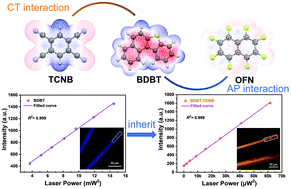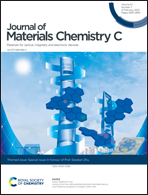Cocrystal engineering for constructing two-photon absorption materials by controllable intermolecular interactions†
Abstract
The design of two-photon absorption (TPA) materials based on cocrystal engineering is an emerging strategy for constructing nonlinear materials. Here we observe that a prepared BDBT-TCNB cocrystal can retain well the TPA properties from the donor BDBT molecules, but the TPA properties of a BDBT-OFN cocrystal are inhibited upon using the same donor molecule but changing the acceptor molecule of the cocrystal. Via comparing the crystal structures and spectral data of the two cocrystals, we find that BDBT-TCNB cocrystals have obvious intermolecular charge transfer interactions, while the BDBT-OFN cocrystals exhibit totally different intermolecular arene–perfluoroarene interactions. Moreover, strong charge transfer interactions involving the BDBT-TCNB cocrystal also promote an enhancement of the fluorescence intensity and an increase in the lifetime and photoluminescence quantum yield (PLQY) relative to the monomers. Therefore, this example proves that intermolecular interactions involving cocrystals can be controlled via carefully selecting the donor and acceptor molecules, and then the TPA properties of the cocrystals can be selectively adjusted, promoting the development of TPA materials prepared via cocrystal engineering.

- This article is part of the themed collection: Special issue in honour of Daoben Zhu


 Please wait while we load your content...
Please wait while we load your content...